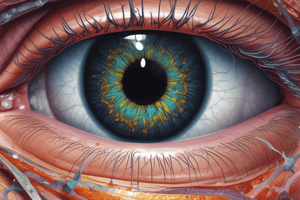Podcast
Questions and Answers
What is the primary pathological event in the formation of hordeolum (Stye)?
What is the primary pathological event in the formation of hordeolum (Stye)?
- Bacterial infection in the eyelids
- Obstruction of the gland orifice (correct)
- Allergic reaction to a mite
- Chronic inflammation in the conjunctiva
Which etiological agent is associated with Blepharitis?
Which etiological agent is associated with Blepharitis?
- Proteus sp.
- Demodex folliculorum (a mite) (correct)
- Azithromycin
- Pseudomonas aeruginosa
What can happen if hordeolum (Stye) does not drain or get incised?
What can happen if hordeolum (Stye) does not drain or get incised?
- Formation of ulcers
- Abscesses may form
- Red nodule in the cornea
- Granuloma formation (correct)
What is the characteristic histopathology of hordeolum (Stye)?
What is the characteristic histopathology of hordeolum (Stye)?
Which bacteria is generally associated with Hordeolum and Chalazion?
Which bacteria is generally associated with Hordeolum and Chalazion?
What is the treatment for an allergic reaction in Blepharitis?
What is the treatment for an allergic reaction in Blepharitis?
Which antibiotic is recommended for susceptible strains and for prevention of corneal and conjunctival infections?
Which antibiotic is recommended for susceptible strains and for prevention of corneal and conjunctival infections?
What is the most common etiological agent for Acute Dacryocystitis?
What is the most common etiological agent for Acute Dacryocystitis?
What is a characteristic symptom of Chronic Dacryocystitis?
What is a characteristic symptom of Chronic Dacryocystitis?
What is the etiological agent of Ocular Lymphogranuloma Venereum?
What is the etiological agent of Ocular Lymphogranuloma Venereum?
How does Ocular Lymphogranuloma Venereum differ from trachoma and inclusion conjunctivitis?
How does Ocular Lymphogranuloma Venereum differ from trachoma and inclusion conjunctivitis?
What is the treatment option with caution in children for Trachoma?
What is the treatment option with caution in children for Trachoma?
Study Notes
Etiological Agents of Eye Diseases
- Etiological agents affecting the eyes vary depending on the area and type of tissue affected
- Disease spread can be divided into:
- Eyelids and surrounding tissue
- Conjunctiva
- Cornea
- Intraocular area
Blepharitis
- Etiological agent: Demodex folliculorum (a mite) followed by bacterial infection (Staphylococcus aureus or Staphylococcus epidermidis)
- Diagnosis: allergic reaction to the mite, abscesses may form in and around follicles, destroying follicles, with loss of lashes and ulcer formation
- Treatment: glucocorticoid for allergic reaction, doxycycline or minocycline, azithromycin (alternative)
Hordeolum and Chalazion
- Etiological agents: Staphylococcus aureus, Pseudomonas aeruginosa, and Proteus sp.
- Diagnosis: obstruction of gland orifice (Meibomian, Zeis, or Moll), red nodule with yellowish top, histopathology shows acute suppurative inflammation
- Chalazion evolves from hordeolum that do not drain spontaneously or are not incised
- Treatment: erythromycin for susceptible strains, cephalexin for acute hordeolum, doxycycline for recurrent lesions or meibomitis
Acute Dacryocystitis
- Etiological agents: S. aureus, S. epidermidis, Streptococcus pneumoniae
- Diagnosis: infection of lacrimal sac, usually secondary to obstruction of lacrimal duct, pain in tear sac area, erythema, edema, purulent discharge, and epiphora
- Treatment: coamoxiclav, sultamicillin, levofloxacin, tobramycin ophthalmic, tobramycin plus dexamethasone ophthalmic
Chronic Dacryocystitis
- Etiological agents: Streptococcus pneumoniae, Haemophilus influenzae, Candida albicans, Aspergillus spp., Actinomyces spp.
- Diagnosis: partial or complete obstruction within lacrimal sac or nasolacrimal duct, conjunctivitis, chronic or acute, and severe inflammation of the cornea
- Treatment: topical sulfacetamide, erythromycin, ciprofloxacin, gatifloxacin, or ofloxacin, besifloxacin (ophthalmic suspension)
Ocular Lymphogranuloma Venereum
- Etiological agent: Chlamydia trachomatis
- Diagnosis: chlamydial disease transmitted to fetus during birth, inflammation begins about five days after birth, no follicle formation, corneal scars, conjunctival scars, and micro pannus formation
- Treatment: azithromycin, erythromycin, doxycycline (DOC, caution in children)
Trachoma
- Etiological agent: Chlamydia trachomatis
- Diagnosis: disease limited to man, infecting only epithelial cells of the eye and possibly nasopharynx, no systemic involvement, found worldwide, greatest single cause of blindness
Studying That Suits You
Use AI to generate personalized quizzes and flashcards to suit your learning preferences.
Description
Test your knowledge on the etiological agents that can affect the eyes, including diseases spread to different areas and types of eye tissue. This quiz covers various conditions like blepharitis, conjunctivitis, corneal infections, and intraocular diseases.




